Nuala Ní Chonchúir's Blog, page 14
October 17, 2015
Kildare Readers Fest with Dermot Bolger
Dermot Bolger and I will be reading at Kildare Readers Festival tomorrow, Sunday. 12.30pm. More here.
Published on October 17, 2015 01:56
October 15, 2015
ANNAGHMAKERRIG & EMILY D'S CONSERVATORY
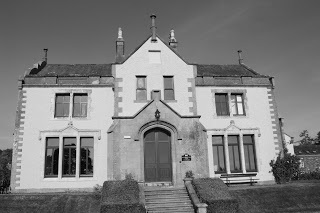 Tyrone Guthrie Centre, Annaghmakerrig
Tyrone Guthrie Centre, Annaghmakerrig
 Supergrover admiring the art in our Annaghmakerring bedroomI am on retreat all this week at the Tyrone Guthrie Centre in Annaghmakerrig, County Monaghan, hammering novel #4 into shape. It is not going badly at all. I was absolutely dreading re-reading the MS, a first draft of which I finished in late April. But, you know, it is proving to be a pleasing read/edit so far and I am relieved and thankful for that.
Supergrover admiring the art in our Annaghmakerring bedroomI am on retreat all this week at the Tyrone Guthrie Centre in Annaghmakerrig, County Monaghan, hammering novel #4 into shape. It is not going badly at all. I was absolutely dreading re-reading the MS, a first draft of which I finished in late April. But, you know, it is proving to be a pleasing read/edit so far and I am relieved and thankful for that.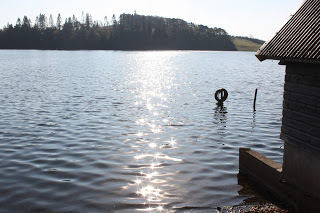 Annaghmakerrig LakeA few of us stayed up til the wee hours this morning, talking feminism and writing, and we had a very jolly time. Too jolly maybe - we're all a little tender today. I am going to go out by the lake for more air shortly; my head is befogged.
Annaghmakerrig LakeA few of us stayed up til the wee hours this morning, talking feminism and writing, and we had a very jolly time. Too jolly maybe - we're all a little tender today. I am going to go out by the lake for more air shortly; my head is befogged.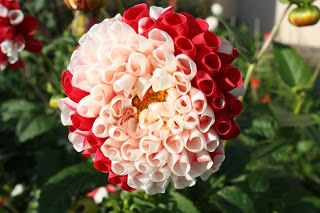 The gardens here are aglow with dahliasMeanwhile in Massachusetts, work continues on Emily Dickinson's house and the latest project is the restoration of Emily's beloved conservatory, her 'little garden within'. See below for details and please consider helping the work along with a small donation. Or, if you're loaded, a large one :)
The gardens here are aglow with dahliasMeanwhile in Massachusetts, work continues on Emily Dickinson's house and the latest project is the restoration of Emily's beloved conservatory, her 'little garden within'. See below for details and please consider helping the work along with a small donation. Or, if you're loaded, a large one :) Desk view, Annaghmakerrig
Desk view, Annaghmakerrig
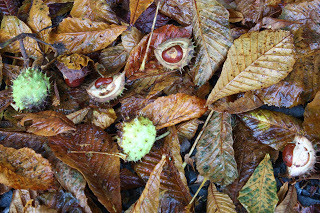 Chestnuts
Chestnuts
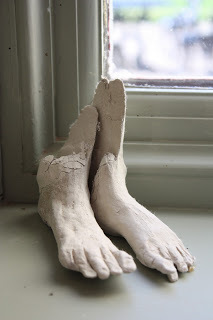 Art in the hallway*
Art in the hallway*The following is the latest newsletter from the Emily Dickinson Museum:
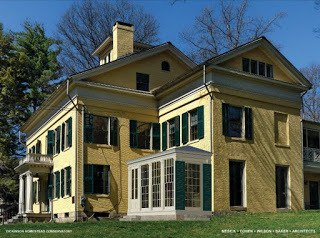 Architects' rendering of the rebuilt conservatoryEmily Dickinson's conservatory was removed in 1916. 100 years later, we're bringing it back. The bedroom, the garden, the kitchen: all are essential spaces that quickly spring to mind when thinking about the physical locations that inspired Dickinson's poetry. The conservatory, built by her father when the family returned to the Homestead in 1855, is another. In this diminutive greenhouse Dickinson maintained her link to the vibrant natural world during the frigid New England winters. She tended flowers "near and foreign," as she wrote to Elizabeth Holland in March 1866, in a space six feet deep and seventeen feet wide where she had "but to cross the floor to stand in the Spice Isles."
Architects' rendering of the rebuilt conservatoryEmily Dickinson's conservatory was removed in 1916. 100 years later, we're bringing it back. The bedroom, the garden, the kitchen: all are essential spaces that quickly spring to mind when thinking about the physical locations that inspired Dickinson's poetry. The conservatory, built by her father when the family returned to the Homestead in 1855, is another. In this diminutive greenhouse Dickinson maintained her link to the vibrant natural world during the frigid New England winters. She tended flowers "near and foreign," as she wrote to Elizabeth Holland in March 1866, in a space six feet deep and seventeen feet wide where she had "but to cross the floor to stand in the Spice Isles."The deep connection between Dickinson and her horticultural pursuits permeated her poetry and daily life. Imagine dirt under the poet's fingernails as she wrote the poems that immortalized flowers blooming in her garden, home, and Amherst wilderness. The conservatory allowed her to follow this passion year round. Through its windows, Dickinson could view the gardens and orchard that she frequented in the warmer months. From the native species and fragile exotic specimens she grew inside would come the blooms and bouquets sent with letters and poems to her beloved friends in even the coldest months of the year. To tell the Dickinson story more fully we need to restore the conservatory.
 1916 image of Emily's conservatoryDismantled in 1916, many of the conservatory's original architectural elements - including its window sash and original door - survive. In the past two years archaeological investigations of the southeastern corner of the house where the conservatory stood have unearthed its foundations and other important historical details. With photographic, documentary, archaeological, and even poetic evidence in hand, we're ready to bring Emily Dickinson's conservatory back to life. But we'll need your help to do it.
1916 image of Emily's conservatoryDismantled in 1916, many of the conservatory's original architectural elements - including its window sash and original door - survive. In the past two years archaeological investigations of the southeastern corner of the house where the conservatory stood have unearthed its foundations and other important historical details. With photographic, documentary, archaeological, and even poetic evidence in hand, we're ready to bring Emily Dickinson's conservatory back to life. But we'll need your help to do it.Our fundraising goal for reconstructing and maintaining the conservatory is $300,000, of which over $100,000 has already been raised.
Since its founding in 2003, the Emily Dickinson Museum has undertaken several projects that provide visitors with a more authentic understanding of the world inhabited by the Dickinsons. The restoration of Emily Dickinson's bedroom and library, return of the hedge and fence that connect the Homestead and Evergreens properties, repainting of the homes in their historic colors, and, coming soon, an heirloom orchard allow visitors to step back in time through a personal encounter with the poet's world possible nowhere else. The conservatory will add another critical detail to that immersive experience.
In her letter to Mrs. Holland, Dickinson also wrote that "We do not always know the source of the smile that flows to us." We hope that this project provokes many joyful smiles among those who care about the Museum's mission of interpreting and sharing the story of Emily Dickinson and her family. You can express a bit of that joy by contributing to making the conservatory a reality. We thank you in advance for your support of this latest step in returning the Museum grounds to a place Emily Dickinson would have recognized and in which she would have felt at home.
Donate to the Conservatory Reconstruction Fund by contacting the development office at 413-542-5084 or development@EmilyDickinsonMuseum.org. Or donate online here.
Published on October 15, 2015 07:58
October 10, 2015
THE GUARDIAN - MISS EMILY REVIEW
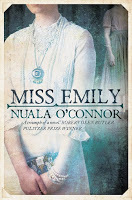
Thrilled with this Guardian review of Miss Emily from Jane Housham - short but positive. My first ever Guardian review - wheee! I'm putting the whole text here in case the link vamooses.
Miss Emily by Nuala O'Connor - Review:
The Secret Life of Emily Dickinson
The ‘“Miss Emily” of the title is the 19th-century poet Emily Dickinson. Into a meticulous re-creation of the Dickinson family home in Amherst, Massachusetts, Irish novelist Nuala O’Connor introduces a fictional maid-of-all-work, Ada Concannon, fresh off the boat from Dublin. In alternating first-person accounts by her two protagonists, O’Connor explores Dickinson’s strong capacity for friendship in spite of her impulse to withdraw from the company of others. Her defining openness to the world allows her (compels her, even) to ignore the conventions of class and to see in lowly Ada someone worth knowing. Living under the same roof, the two women find common ground in a love of baking – and Ada’s use of language, untutored but rich in Irish idiom, is a pleasure and stimulus to the poet’s ear. Lyndall Gordon’s 2010 book on Dickinsonsuggested that her reclusive lifestyle and even her insistence on wearing white dresses might be explained by a medical diagnosis, but here they are interpreted as an effort to free her imagination within self-imposed restrictions. Both women suffer a loss of freedom (Ada’s particularly harrowing) and, through their friendship, find a kind of escape as well.To order Miss Emily for £6.99 (RRP £8.99) go to hop.theguardian.com or call 0330 333 6846. Free UK p&p over £10, online orders only. Phone orders min p&p of £1.99.
Published on October 10, 2015 03:17
October 8, 2015
October 7, 2015
EMILY'S BEDROOM RESTORED
I have lifted the entire text of what follows from the Emily Dickinson Museum newsletter:
"The room comes alive": A celebration of Emily Dickinson's bedroom restoration
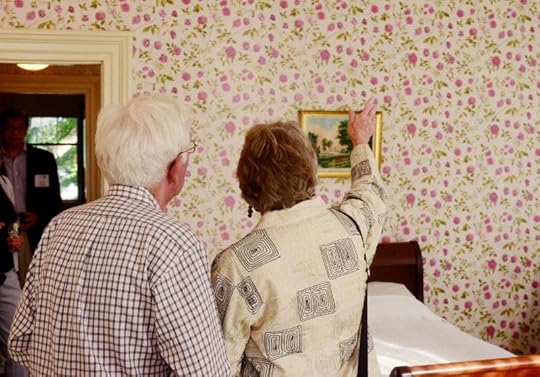
AMHERST, MA - It's surprising. Now, when you step into Emily Dickinson's bedroom, which also served as her writing studio, you see color. Bolder hues have replaced the wallpaper hung in the 1960s when the Homestead was still a residence. Light streams through lace curtains at four large windows and dances across the reddish pink of roses and spring green of leaves hanging on a background lattice pattern. Far from a muted, neutral space that seemed to reinforce a ghostlike image of the famously reclusive poet, the restored bedroom is warm, colorful, and vivacious.
"The room comes alive now, with the curtains and wallpaper and pictures that were here when Dickinson lived here, the beautifully reproduced desk and bureau, and the original bed," said Polly Longsworth, former Chair of the Museum's Board of Governors, as she viewed the fully restored room for the first time. "It's just wonderful."
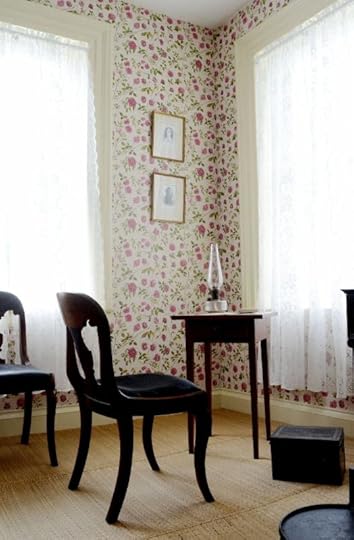
Emily Dickinson, now recognized as one of the world's greatest poets, occupied the southwest chamber of the family Homestead in her adult years. There she wrote all but a few of the nearly 2,000 poems that make up her opus. Just a handful were published, all without her assent, during her lifetime. Only after her death were hundreds of poem manuscripts found in her room by her sister, Lavinia. Dickinson's work became known to the public through the publication efforts of Lavinia and first editors Mabel Loomis Todd and Thomas Wentworth Higginson.
"This was a tremendous project for the Emily Dickinson Museum, the most significant step we've taken toward re-creating Dickinson's everyday surroundings. As we close this project and celebrate its completion, we're really opening a new era for the Emily Dickinson Museum and how we introduce visitors to this magnificent poet," said Emily Dickinson Museum Executive Director Jane Wald.
READ AMHERST COLLEGE'S STORY ON THE BEDROOM RESTORATION HERE.
The restoration of Dickinson's bedroom was celebrated on Saturday, September 26, marking the completion of two years of work that saw 20th century additions stripped away to reveal Dickinson's original 19th-century space. The process revealed architectural details that allowed historians, architects, designers and a crew of other experts involved in the project to accurately recreate a room that is prominently woven into American literature along with other Massachusetts landmarks like Thoreau's cabin on Walden Pond, Alcott's Orchard House, and Wharton's Mount.
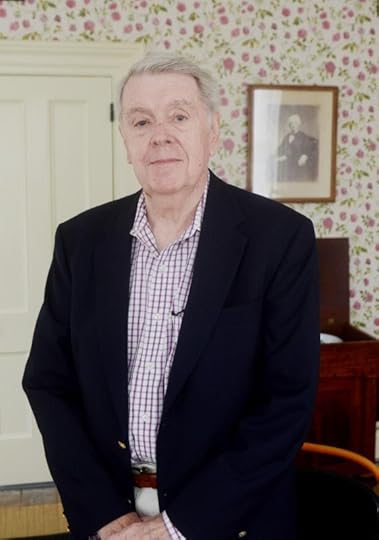 William McC. Vickery"It looks remarkable," said William McC. Vickery, the former member of the Emily Dickinson Museum Board of Governors who provided the seed gift establishing the restoration's initial funding. "I can now see Emily Dickinson in this bedroom, writing at her desk and storing her poems in that bureau, and I think everybody has a much different impression of what this bedroom meant to her than we did beforehand."The bedroom restoration is the latest of an ongoing series of projects that began with the incorporation of the museum in 2003, which brought together Dickinson's house, the Homestead, with her brother's home, The Evergreens, next door. Work has included the restoration of the hedge and fence surrounding the Dickinsons' property, the painting of the Homestead and The Evergreens in their original colors, archaeological investigations, and a wide assortment of repairs necessary to keep the houses intact.
William McC. Vickery"It looks remarkable," said William McC. Vickery, the former member of the Emily Dickinson Museum Board of Governors who provided the seed gift establishing the restoration's initial funding. "I can now see Emily Dickinson in this bedroom, writing at her desk and storing her poems in that bureau, and I think everybody has a much different impression of what this bedroom meant to her than we did beforehand."The bedroom restoration is the latest of an ongoing series of projects that began with the incorporation of the museum in 2003, which brought together Dickinson's house, the Homestead, with her brother's home, The Evergreens, next door. Work has included the restoration of the hedge and fence surrounding the Dickinsons' property, the painting of the Homestead and The Evergreens in their original colors, archaeological investigations, and a wide assortment of repairs necessary to keep the houses intact.
"The work over the past twelve years is a textbook example of exactly how to approach a site like this," said Eric Gradoia, architectural historian and conservator for Mesick, Cohen, Wilson, Baker Architects, who helped to create the restoration plan for the Homestead and The Evergreens. "As we peeled apart the bedroom and started to look at it, there was a wealth of evidence. The majority of the Dickinson period material is still here in the house, it's just hidden away behind much later additions and changes. Hopefully the bedroom is just the beginning of a much greater and grander restoration of the Homestead."
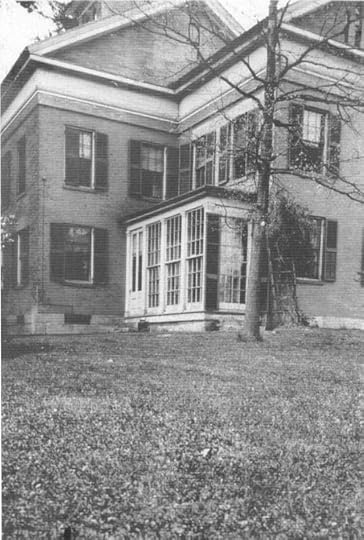 Emily Dickinson's conservatoryWith the bedroom restoration complete, the Emily Dickinson Museum is now focused on the next major project: recreating Dickinson's garden conservatory. Built by her father, Edward Dickinson, in 1855, the conservatory was a crucial tie throughout the cold New England winter to the natural world she loved. This project, like the bedroom, is based on years of historical and archaeological research. Photographs from 1916, the year it was dismantled, provide useful documentation as do some of the original building materials saved on site. One hundred years later, the museum hopes to reconstruct the conservatory to add another chapter to the interpretive story of Dickinson's daily life. $100,000 of the $300,000 needed to complete the project has been raised, and the fundraising goal is to meet the complete tally by December 2016.
Emily Dickinson's conservatoryWith the bedroom restoration complete, the Emily Dickinson Museum is now focused on the next major project: recreating Dickinson's garden conservatory. Built by her father, Edward Dickinson, in 1855, the conservatory was a crucial tie throughout the cold New England winter to the natural world she loved. This project, like the bedroom, is based on years of historical and archaeological research. Photographs from 1916, the year it was dismantled, provide useful documentation as do some of the original building materials saved on site. One hundred years later, the museum hopes to reconstruct the conservatory to add another chapter to the interpretive story of Dickinson's daily life. $100,000 of the $300,000 needed to complete the project has been raised, and the fundraising goal is to meet the complete tally by December 2016.
"A complete restoration of the Homestead and Evergreens is made up of a number of individual steps," says Wald. "As we advance in this process, we hope the value of preserving this center of American literature becomes ever more clearly evident. Emily Dickinson so identified with home and Amherst that she even signed a letter with the name of the town rather than her own. The town, of course, has grown and changed. But within the borders of the fence and hedge, we hope to evoke Dickinson's 19th-century surroundings, a place that she would have recognized and in which she would have felt at home."
See Emily Dickinson's restored bedroom, and learn more of the details of the renovation, during one of our guided tours, offered Wednesday through Sunday, 11 am to 4 pm.
"The room comes alive": A celebration of Emily Dickinson's bedroom restoration


AMHERST, MA - It's surprising. Now, when you step into Emily Dickinson's bedroom, which also served as her writing studio, you see color. Bolder hues have replaced the wallpaper hung in the 1960s when the Homestead was still a residence. Light streams through lace curtains at four large windows and dances across the reddish pink of roses and spring green of leaves hanging on a background lattice pattern. Far from a muted, neutral space that seemed to reinforce a ghostlike image of the famously reclusive poet, the restored bedroom is warm, colorful, and vivacious.
"The room comes alive now, with the curtains and wallpaper and pictures that were here when Dickinson lived here, the beautifully reproduced desk and bureau, and the original bed," said Polly Longsworth, former Chair of the Museum's Board of Governors, as she viewed the fully restored room for the first time. "It's just wonderful."

Emily Dickinson, now recognized as one of the world's greatest poets, occupied the southwest chamber of the family Homestead in her adult years. There she wrote all but a few of the nearly 2,000 poems that make up her opus. Just a handful were published, all without her assent, during her lifetime. Only after her death were hundreds of poem manuscripts found in her room by her sister, Lavinia. Dickinson's work became known to the public through the publication efforts of Lavinia and first editors Mabel Loomis Todd and Thomas Wentworth Higginson.
"This was a tremendous project for the Emily Dickinson Museum, the most significant step we've taken toward re-creating Dickinson's everyday surroundings. As we close this project and celebrate its completion, we're really opening a new era for the Emily Dickinson Museum and how we introduce visitors to this magnificent poet," said Emily Dickinson Museum Executive Director Jane Wald.
READ AMHERST COLLEGE'S STORY ON THE BEDROOM RESTORATION HERE.
The restoration of Dickinson's bedroom was celebrated on Saturday, September 26, marking the completion of two years of work that saw 20th century additions stripped away to reveal Dickinson's original 19th-century space. The process revealed architectural details that allowed historians, architects, designers and a crew of other experts involved in the project to accurately recreate a room that is prominently woven into American literature along with other Massachusetts landmarks like Thoreau's cabin on Walden Pond, Alcott's Orchard House, and Wharton's Mount.
 William McC. Vickery"It looks remarkable," said William McC. Vickery, the former member of the Emily Dickinson Museum Board of Governors who provided the seed gift establishing the restoration's initial funding. "I can now see Emily Dickinson in this bedroom, writing at her desk and storing her poems in that bureau, and I think everybody has a much different impression of what this bedroom meant to her than we did beforehand."The bedroom restoration is the latest of an ongoing series of projects that began with the incorporation of the museum in 2003, which brought together Dickinson's house, the Homestead, with her brother's home, The Evergreens, next door. Work has included the restoration of the hedge and fence surrounding the Dickinsons' property, the painting of the Homestead and The Evergreens in their original colors, archaeological investigations, and a wide assortment of repairs necessary to keep the houses intact.
William McC. Vickery"It looks remarkable," said William McC. Vickery, the former member of the Emily Dickinson Museum Board of Governors who provided the seed gift establishing the restoration's initial funding. "I can now see Emily Dickinson in this bedroom, writing at her desk and storing her poems in that bureau, and I think everybody has a much different impression of what this bedroom meant to her than we did beforehand."The bedroom restoration is the latest of an ongoing series of projects that began with the incorporation of the museum in 2003, which brought together Dickinson's house, the Homestead, with her brother's home, The Evergreens, next door. Work has included the restoration of the hedge and fence surrounding the Dickinsons' property, the painting of the Homestead and The Evergreens in their original colors, archaeological investigations, and a wide assortment of repairs necessary to keep the houses intact."The work over the past twelve years is a textbook example of exactly how to approach a site like this," said Eric Gradoia, architectural historian and conservator for Mesick, Cohen, Wilson, Baker Architects, who helped to create the restoration plan for the Homestead and The Evergreens. "As we peeled apart the bedroom and started to look at it, there was a wealth of evidence. The majority of the Dickinson period material is still here in the house, it's just hidden away behind much later additions and changes. Hopefully the bedroom is just the beginning of a much greater and grander restoration of the Homestead."
 Emily Dickinson's conservatoryWith the bedroom restoration complete, the Emily Dickinson Museum is now focused on the next major project: recreating Dickinson's garden conservatory. Built by her father, Edward Dickinson, in 1855, the conservatory was a crucial tie throughout the cold New England winter to the natural world she loved. This project, like the bedroom, is based on years of historical and archaeological research. Photographs from 1916, the year it was dismantled, provide useful documentation as do some of the original building materials saved on site. One hundred years later, the museum hopes to reconstruct the conservatory to add another chapter to the interpretive story of Dickinson's daily life. $100,000 of the $300,000 needed to complete the project has been raised, and the fundraising goal is to meet the complete tally by December 2016.
Emily Dickinson's conservatoryWith the bedroom restoration complete, the Emily Dickinson Museum is now focused on the next major project: recreating Dickinson's garden conservatory. Built by her father, Edward Dickinson, in 1855, the conservatory was a crucial tie throughout the cold New England winter to the natural world she loved. This project, like the bedroom, is based on years of historical and archaeological research. Photographs from 1916, the year it was dismantled, provide useful documentation as do some of the original building materials saved on site. One hundred years later, the museum hopes to reconstruct the conservatory to add another chapter to the interpretive story of Dickinson's daily life. $100,000 of the $300,000 needed to complete the project has been raised, and the fundraising goal is to meet the complete tally by December 2016. "A complete restoration of the Homestead and Evergreens is made up of a number of individual steps," says Wald. "As we advance in this process, we hope the value of preserving this center of American literature becomes ever more clearly evident. Emily Dickinson so identified with home and Amherst that she even signed a letter with the name of the town rather than her own. The town, of course, has grown and changed. But within the borders of the fence and hedge, we hope to evoke Dickinson's 19th-century surroundings, a place that she would have recognized and in which she would have felt at home."
See Emily Dickinson's restored bedroom, and learn more of the details of the renovation, during one of our guided tours, offered Wednesday through Sunday, 11 am to 4 pm.
Published on October 07, 2015 01:57
October 4, 2015
TASTEBOOK PIECE ON EMILY DICKINSON & BAKING

I managed to miss this when it was posted, but how lovely is the illustration that goes with it? It's by Ariella Elovic. My piece on Emily Dickinson and baking here at Tastebook.
Published on October 04, 2015 03:56
October 3, 2015
*MISS EMILY* INTERVIEW ON GALWAY BAY FM
I was interviewed by Keith Finnegan, in the company of Desi Kenny of Kennys Book Shop, on Galway Bay FM on Friday. Starts at about 59 minutes in here.
Published on October 03, 2015 03:41
October 1, 2015
GALWAY ADVERTISER REVIEW OF MISS EMILY
Des Kenny, of Kennys Bookshop, reviews Miss Emily in the
Galway Advertiser
today. I will be on the Keith Finnegan Show on Galway Bay FM with Des tomorrow (10.30am-ish) to discuss the book.
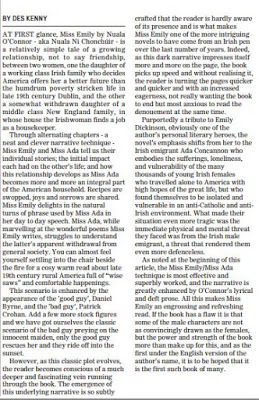

Published on October 01, 2015 01:39
September 30, 2015
*OF DUBLIN & OTHER FICTIONS* REVIEW
My chapbook of flash, Of Dublin and Other Fictions, has been reviewed by Peter Blair in Flash, the International Short-short Story Magazine. Click and zoom to read.
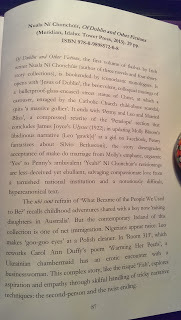
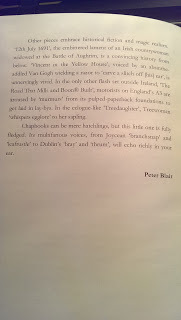


Published on September 30, 2015 02:58
September 28, 2015
BIG SMOKE NEWS
Big Smoke Writing Factory are moving to a new home at 1 Coppinger Row, Dublin, between South William St and Clarendon St - view on the map here.
Their classes are starting in the next week or so - still a couple of places on most of them so, if interested, get booking.
- Commit To Your First Draft (intermediate/advanced; starting Monday September 28th)
- Intermediate Creative Writing (intermediate; starting Tuesday September 29th)
- Your Second Draft (advanced; starting Wednesday September 30th)
- Beginning To Write (beginners; starting Thursday October 1st)
- Poetry: Reading, Writing, Editing (intermediate/advanced; starting Monday October 5th)
You can get in touch if you've any questions about any of the courses.
Their classes are starting in the next week or so - still a couple of places on most of them so, if interested, get booking.
- Commit To Your First Draft (intermediate/advanced; starting Monday September 28th)
- Intermediate Creative Writing (intermediate; starting Tuesday September 29th)
- Your Second Draft (advanced; starting Wednesday September 30th)
- Beginning To Write (beginners; starting Thursday October 1st)
- Poetry: Reading, Writing, Editing (intermediate/advanced; starting Monday October 5th)
You can get in touch if you've any questions about any of the courses.
Published on September 28, 2015 02:02
Nuala Ní Chonchúir's Blog
- Nuala Ní Chonchúir's profile
- 41 followers
Nuala Ní Chonchúir isn't a Goodreads Author
(yet),
but they
do have a blog,
so here are some recent posts imported from
their feed.



